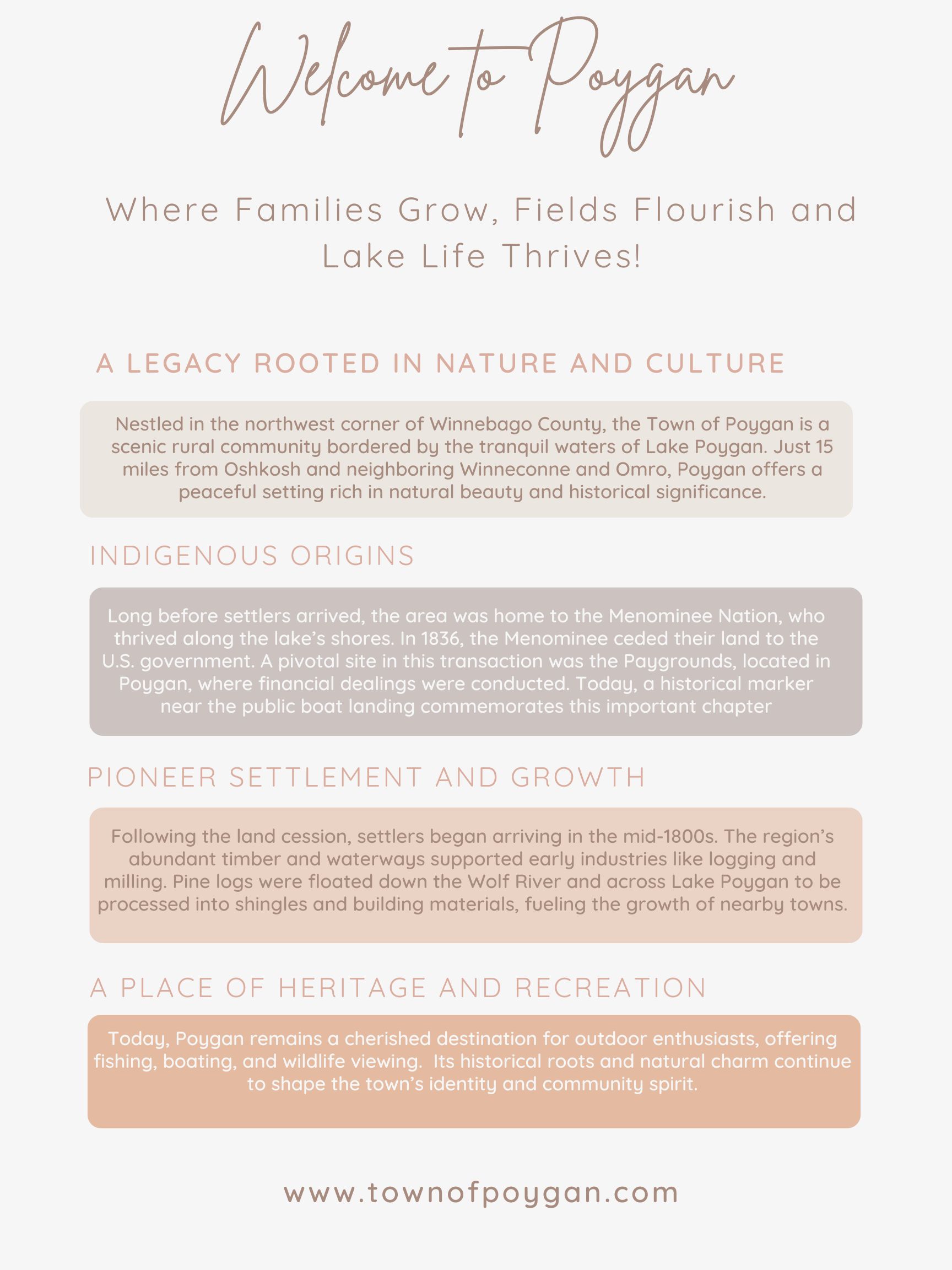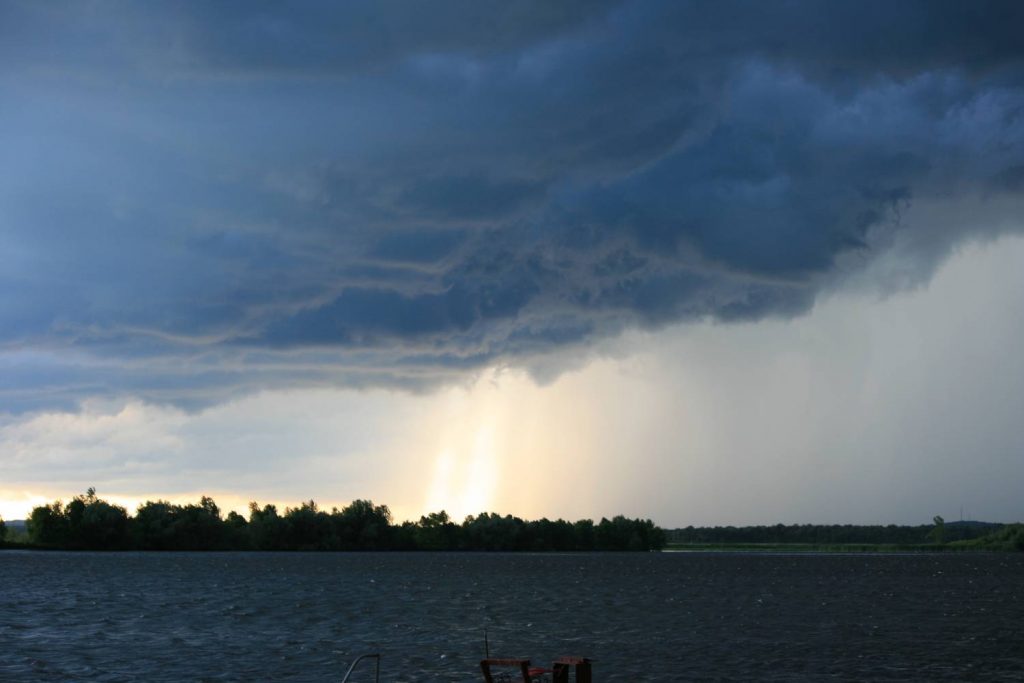
Town of Poygan History
The Town of Poygan is situated in a rural, open area, which is consistently identified as one of the unique characteristics valued by residents. The Town’s setting on the shores of Lake Poygan allows for abundant natural resources, including wildlife, wetlands and recreational lands. The Town is located in the Northwest corner of Winnebago County and is approximately 15 miles from Oshkosh. Winneconne and Omro are neighboring communities.
With a rich cultural history the Town of Poygan was first inhabited by the Menominee Indians. In 1836, the Menominee ceded their land to the U.S. Government, and all financial dealings related to this land transaction occurred at the Paygrounds, which were located in the Town of Poygan. A permanent historical marker, donated by the Winnebago County Historical Society in 1956, commemorates these events near public boat landing of County Road B.
After surrendering their land, the Menominees moved to and settled in the Town of Poygan and spread their tepees along the lakeshore. For a period of time under the leadership of Menominee Chief Grisley Bear, a thriving village existed in the Town. However, in late fall of 1852, over 2000 encamped Menominee, including women, children, and the elderly, along with all of their meager possessions, were ordered to canoe out of Poygan and travel up the Wolf River to their new
wilderness lands. Father Bonduel, the spiritual leader of Poygan and the Menominees, accompanied the Indians, caring for the sick, feeble and dying, along the grim and dangerous trek north.
The early white settlers did not wait until the Indians were moved off before they moved in. Settlers with the last names Keefe, Rawson, Caulkins, Cole, Barrons, Felton, Schofield, Tritt and Wood, had settled in before 1851 and by 1852 a post office had been established. By 1908, there were six schoolhouses, a church and a town hall. The roads were considered “good” and the township had fine farm buildings.
More people of Irish descent lived in Poygan, than in any other town in the county. German immigrants soon followed. Religion was important to both groups of early settlers and a Catholic parish was established with meetings taking place in a log cabin as early as 1844. A Catholic church, St Thomas Aquinas, was built on Poygan Hill in 1860. The church is no longer in use, but still stands and is open for special events.
Agriculture has long had a place in the history of Poygan. With the decline of the old style farm, cropland has become woodland or marsh. Other former family farmland has been sold or rented to larger corporate farms operations, either dairy or crop. Cranberries, lettuce, celery and honey were among the more unusual cash crops raised in the township over the course of history.
In 1900, 742 residents were counted in the Town of Poygan and due to the remoteness of the area the population has been quite steady. The total township population in 1996 was 877. The Wisconsin Department of Administration estimated the 2002 population for the Town of Poygan at 1093.
Poygan is now homeland and playground for vacationers, commuters and retirees. The transition from summer cabins to year-round homes by non-farm rural residents was made possible by the graveling of the local roads in the 1920’s and the paving of same in the 1950’s-and by the coming of electricity that made the modern conveniences, such as running water, possible. A public sewer system brought into the area in early 1990s has made even more development along the lake feasible.
In addition to its rich cultural history, Poygan has an abundance of natural resources. The Town natural resource amenities include Lake Poygan and the Deppe Marsh State Wildlife Area, which is located in the southwest corner of the Town and harbors many species of wildlife. Additionally, the Town of Poygan is located within the Glacial Habitat Restoration Area, which is a regional wildlife habitat protection area.
The DNR has purchased hundreds of acres of land over the years, which is available for public hunting. Our local area conservation club sponsors a pheasant release program in the township. Deer and turkey hunting are also a popular sport here as well as small game hunting.
Boating, fishing and water sports are some of the activities on Lake Poygan. There are three boat landings on the lake, two private and one public landing on County Road B. Duck hunters are out in the fall and you’ll find a small city of ice shanties in the winter when the fish are biting or during Sturgeon spearing season.
Historically, agriculture has provided the basis of the Town’s economy. However, as new growth occurs, this lifestyle and economic livelihood has changed. Poygan has started to become a bedroom community with many of its residents commuting to the Fox Cities for employment.
Businesses in the Town of Poygan include Haase’s Supper Club, Captain’s Cove Bar and Boat Landing, The Hill Tavern, and Noffke’s Boat Landing. Landmarks include Payground Historical Marker, St Thomas Catholic Church, St Thomas Cemetery, Oakhill Cemetery, and the Forest Hill Cemetery. Organizations serving the town include the Poyganires Snowmobile Club which not only marks the local snowmobile trail but whose main function is to support the Poygan Rescue Airboat which is locally owned by the Norman Lee family. The Poygan Conservation Club’s fundraisers include a Water Volleyball Tournament on Lake Poygan and an Ice Fishery in the winter. The Friends of St Thomas work to preserve the historical St Thomas Church.
Though there has been little change in population in the Town of Poygan since 1900, there have been many changes through the history of the township. From a lake of rice, to the home of Native Americans, to the home of new immigrants, to a farm community, to a bedroom community Poygan has been and always will be a place to call home.
Sources:
- The Town of Poygan Comprehensive Planning Committee, Shreiber/Anderson Associates and Rudd and Associates, “Comprehensive Plan 2025, Town of Poygan, Wisconsin” May 2004 pages 4 & 5.
- Velte, Chas. H., “Historic Lake Poygan”, Amherst WI: Palmer Publications Inc., 1976. Page 119.
- Winnebago County Historical Society, “In This Century-History of Winnebago County in the 20th Century” Friendship WI: New Past Press Inc., 1998. Pages 189, 190, & 191.
Compiled by Rose Luebke
















